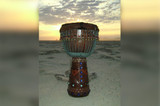Kalimba and Music Therapy
The Kalimba is an African percussion instrument that can be found in classrooms, drum circles and featured in different genres of music. It goes by many names, depending on its cultural influence, including the "thumb piano," a term coined from the method of playing. Originally, Kalimbas were constructed from gourds, using metal scraps to form the keys. Today, the Kalimba can be found in shapes and sizes that vary from gourds to squares, circles and more stylized shapes.
Kalimbas have a distinct presence in the world of music therapy today that provides noteworthy health and wellness benefits to people with physical disabilities, brain injuries, hearing impairments, depression, and those with autism spectrum disorder. Music therapists use the Kalimba in various ways, depending on the patient’s needs and comfort level.
Playing the Kalimba for infants can help calm and soothe, helping new mothers feel less overwhelmed while creating a lasting connection between the mother and child. It can also be used prenatally to stimulate a fetus by playing it against the mother’s abdomen, allowing the sound and vibration to reach the baby.
Physical disabilities, including problems with gait, or mobility issues that may arise from arthritis can be addressed with the sound of the Kalimba, by its very design that creates music with the smallest movements of the thumbs. In addition to the benefits felt by the sound or playing of the Kalimba, the vibrations produced from the Kalimba can relax different muscle groups, and these same vibrations give those with hearing impairments the chance to experience music through the sense of touch.
To relieve stress or ease depression, the act of creating music can be an important therapeutic tool. With the Kalimba, the sound created is light and whimsical, enabling positive mood changes. The instrument is as easy, or complex, as the player wants it to be, giving control over the amount of time and dedication to its music as desired; players can pluck a few keys to create an improvisational melody, or practice well-known songs, depending on time, ability and motivation.
The benefits of the Kalimba positively impact a variety of physical, neurological and emotional wellness concerns, and as such, music therapists are integrating this African percussion instrument into the therapeutic environment. With benefits similar to those of drumming and the didgeridoo, the Kalimba promises to increase the quality of life for people for years to come.
Recent Posts
-
What is the Best Size Djembe for Beginners?
If you're new to the world of percussion and interested in learning the djembe, you're in for a t …16th Jul 2024 -
The Benefits of Becoming a Drumming Teacher: Transforming Passion into Profession
Why become a drumming teacher? Becoming a drumming teacher is an excellent way to share your pas …22nd May 2024 -
What Makes the Djembe Drum a Spiritual Instrument in African Music?
Origin and history of the Djembe drum The Djembe drum originates from West Africa and holds sign …16th May 2024



